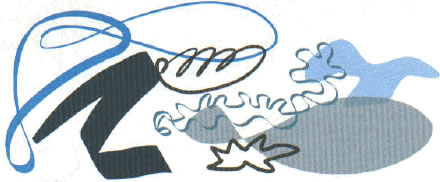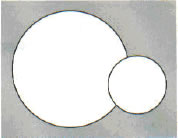Elements of Art
The common language of artists
Elements of Art
Shape
Have you ever tried to design something using only lines? If you did, what happened when one line circled back on itself or it crossed another  line? You formed different shapes. Shape is the element of design that is two-dimensional and encloses space; it tells you whether something is a banana, a cloud, a car, or a toy.
line? You formed different shapes. Shape is the element of design that is two-dimensional and encloses space; it tells you whether something is a banana, a cloud, a car, or a toy.
When a line travels a distance and returns to its starting point, it encloses space and creates shape. Shapes fall into two basic categories—organic and geometric.
Organic shapes are free-flowing, like the following shapes.

 Do you see how the shapes lie one on top of another? This is called overlapping and is used to create depth in a picture. If one shape or object covers part of the visible surface of another, the first shape or object appears to be nearer. For instance, when a small ball is placed in front of a larger ball (as in the diagram), it appears closer than the larger one, despite it being smaller in size.
Do you see how the shapes lie one on top of another? This is called overlapping and is used to create depth in a picture. If one shape or object covers part of the visible surface of another, the first shape or object appears to be nearer. For instance, when a small ball is placed in front of a larger ball (as in the diagram), it appears closer than the larger one, despite it being smaller in size.
 line? You formed different shapes. Shape is the element of design that is two-dimensional and encloses space; it tells you whether something is a banana, a cloud, a car, or a toy.
line? You formed different shapes. Shape is the element of design that is two-dimensional and encloses space; it tells you whether something is a banana, a cloud, a car, or a toy.When a line travels a distance and returns to its starting point, it encloses space and creates shape. Shapes fall into two basic categories—organic and geometric.
Organic shapes are free-flowing, like the following shapes.

The second category of shapes is the geometric one. Most geometric shapes are easy to recognize—like the circle, square, triangle, pentagon, hexagon.


 Do you see how the shapes lie one on top of another? This is called overlapping and is used to create depth in a picture. If one shape or object covers part of the visible surface of another, the first shape or object appears to be nearer. For instance, when a small ball is placed in front of a larger ball (as in the diagram), it appears closer than the larger one, despite it being smaller in size.
Do you see how the shapes lie one on top of another? This is called overlapping and is used to create depth in a picture. If one shape or object covers part of the visible surface of another, the first shape or object appears to be nearer. For instance, when a small ball is placed in front of a larger ball (as in the diagram), it appears closer than the larger one, despite it being smaller in size.